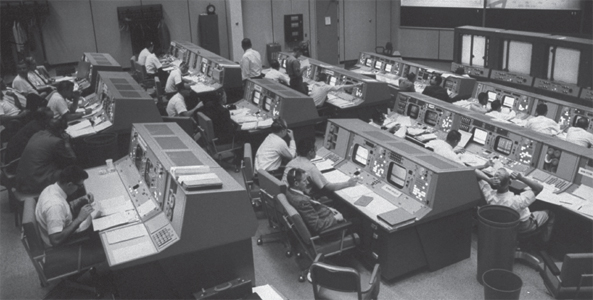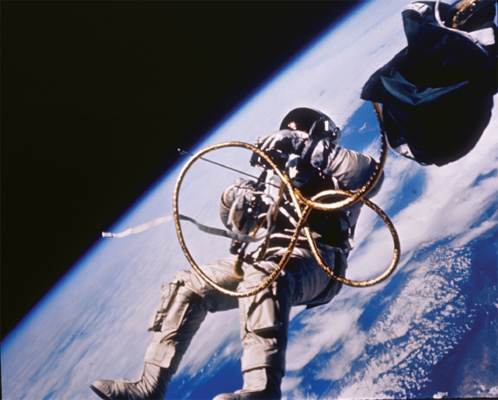
Gemini 4 blasts off at 10:16 A.M. on June 3, 1965. After a brief delay due to a faulty piece of equipment, the launch went smoothly.
The long weeks of training ended at last. Early on the morning of June 3, 1965, Ed White and Jim McDivitt sat down to their preflight breakfast. While they ate steak and eggs, Cape Kennedy’s launchpad LC-19 was buzzing with activity. Inside Gemini, the backup crew checked the ship’s systems. Out on the pad, the ground crew pumped fuel into a giant Titan II rocket. By 7:07 A.M., the Titan was ready to go. When White and McDivitt climbed into the spacecraft, their silvery space suits gleamed in the morning light.1 Each suit displayed an American flag patch—a first for the space program.2
Around the world, television viewers hurried to turn on their sets. For the first time, a space launch was being broadcast live via Early Bird satellite, which allowed events filmed in North America to be viewed in Europe and around the globe. Gemini 4, the news reports promised, would score several “firsts.” Space fans knew that this would be the first mission run from the new Mission Control Center in Houston. For the general public, Ed White’s EVA was the big draw. NASA’s approach to spaceflight was also on display. The Soviets used automated systems to fly their capsules. Cosmonauts never took over the controls unless a major system failed. By contrast, NASA trusted the skills of its former test pilots. Gemini astronauts were expected to take a hands-on role in flying their spacecrafts.3
Only a single glitch marred the countdown. At thirty-five minutes before launch, the erector structure stuck while it was being lowered. Raised to its full height and lowered again, the erector jammed a second time. After a seventy-minute search, workers found and replaced a faulty connector. This time the erector lowered as planned. Gemini 4 was ready.
The Titan II rocket ignited with a burst of bright orange flame at 10:16 A.M. Riding atop the powerful booster, Gemini 4 blasted skyward. Inside the nearly silent cabin, McDivitt and White could feel their spacecraft gathering speed. Then, without warning, the rocket began to bounce like a pogo stick. In Houston, the flight controllers held their breath. If the bouncing continued, the rocket might break apart. Then, in the next instant, the “pogoing” stopped as quickly as it had begun. Everyone in Mission Control sighed with relief.4
Five and a half minutes after liftoff, Gemini 4 coasted into its planned orbit. At its apogee (highest point), the spacecraft was 175 miles (282 kilometers) above Earth. The perigee (low point) checked out at 100 miles (161 kilometers). By this time, the booster’s engines had cut off as planned. Twenty seconds later, McDivitt punched in the order to separate. As his ship pulled free, he used his thrusters to steer clear of the giant booster. A few minutes later, White spotted their fellow traveler about a hundred yards (91 meters) away. As called for in the flight plan, the astronauts set out to simulate a docking maneuver.5

Gemini 4 blasts off at 10:16 A.M. on June 3, 1965. After a brief delay due to a faulty piece of equipment, the launch went smoothly.
Losing Ground by Flying Faster
NASA’s planners assumed that with the booster moving at a constant speed, Gemini 4 could catch it by speeding up. Now, faced with a real space chase, all the old thinking went out the window. Their quarry, McDivitt and White reported, was tumbling along in a different orbit. If they moved in too close, they might crash into the booster. Despite the risk, the astronauts did their best to catch their target. Using thrusters to gain speed, they chased the booster toward their first dawn in space. Then, as the sun rose in a beautiful rainbow of colors, McDivitt called in a surprising report. The booster, he said, was farther away than ever.6
Moments later, the command pilot reported a new problem. “It’s taken a little more fuel than we had anticipated,” he told Mission Control. “Do you want me to really make a major effort to close . . . or to save the fuel?” The response came back almost at once. “I think we should save the fuel . . . I don’t think it’s worth it,” Mission Director Chris Kraft said. McDivitt hated to give up the chase, but he knew the order made sense. “I’d like to save enough [fuel] to help bring me down,” he told Kraft.7

NASA employees work in the Mission Control Center in Houston during the flight of Gemini 4. When the spacecraft burned too much fuel trying to catch the booster rocket, Mission Director Chris Kraft called off the chase to save fuel for Gemini’s return trip.
In Houston, NASA engineers tackled the problem of the elusive booster. Speed and motion in orbit, they decided, do not follow earthly rules. In space, adding speed lifts the spacecraft into a higher orbit. When that happens, the faster-moving ship falls farther and farther behind. Like a runner who takes the outside lane, Gemini lost ground because the higher the orbit, the longer it takes to circle the earth. The target vehicle, following a lower (and shorter) orbit, pulls farther and farther away. In later flights, Gemini pilots closed on their targets by dropping into lower, not higher, orbits. Only when they moved in close did they apply a burst of power. This final thrust allowed the chase ship to close in and dock with its target.8
After failing to catch the booster, the astronauts turned to their next challenge—the EVA. As White assembled the gas gun, McDivitt went over the lengthy checklist. The first task done, White worked on the hookups for his tether and oxygen pack. As the minutes flew by, McDivitt noticed that his partner was looking tired. It would be safer, he thought, to postpone the spacewalk for another orbit. With Houston’s okay, the astronauts took a break.

As Gemini 4 flew over the Indian Ocean, Ed White opened the hatch and stepped into the inky blackness of space.
As Gemini 4 soared over the Indian Ocean, White said he was ready. After struggling with the balky hatch cover, he set up his camera and floated into space. Like all astronauts, he was aware of the danger. If he blacked out, it was unlikely that McDivitt would be able to reel him back into the ship. In that case, the command pilot had orders to cut the spacewalker loose so he could seal the hatch. Buzz Aldrin, who would one day walk on the moon, explained the astronaut’s feelings about risk. “We never believed we were doing anything extraordinarily dangerous,” he said. “[We] were confident in our ability to do the job for which we were exceedingly well trained.”9
After exhausting his gas gun, White used the tether to move around the spacecraft. “Changing my position by pulling on the tether was easy, like pulling a trout . . . out of a stream,” he said later.10 Inside the cabin, the tugs on the tether were keeping McDivitt busy.
The suit was working well, and the helmet visor did a good job of shielding White’s face from the sun’s glare. “I can sit here and see the whole California coast,” he told his worldwide audience. From inside the ship, McDivitt snapped photos of the spacewalker as he floated past. Clearly, White was having a great time. “I’m very thankful in having the experience to be first,” the spacewalker said. “This is fun!”11
All too soon, the order came to end the spacewalk. White pulled himself back to the ship and climbed through the hatch. Closing the cover should have been a simple task, but the stubborn latch again refused to work properly. The long tether, coiling around the cabin like a snake, made the task even more difficult. When White pulled harder, the effort lifted him out of his seat. To aid him, McDivitt reached over, grabbed his legs, and held on tight. As White fought with the cover, his pulse rate climbed to 178 beats a minute. Finally, the latch snapped shut. White dropped into his seat, tired and sweaty—but supremely happy.

Ed White’s gold-coated visor did a good job protecting him from the sun’s glare.
In Houston, the controllers took stock of the situation. The flight plan had called for the astronauts to reopen the hatch so they could toss out the EVA equipment. After the battle with the faulty latch, that seemed too risky. CapCom told White and McDivitt they would have to live with the tether and the rest of the gear for the next three days.

Ed White’s spacewalk lasted for twenty-three minutes. The return to the capsule, he later said, was the “saddest moment” of his life. This photo shows White floating in space as Gemini 4 passes over California.